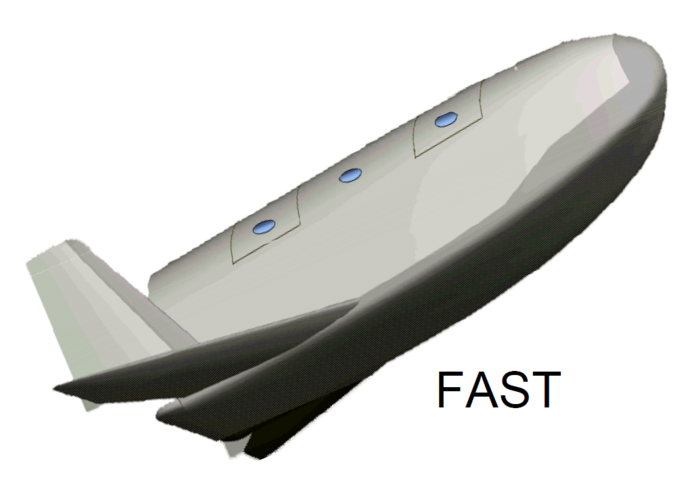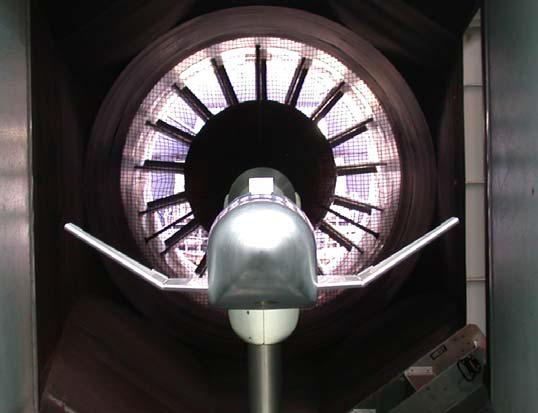- Joined
- 1 April 2006
- Messages
- 11,374
- Reaction score
- 10,200
AFRL Tests Potential Space Vehicle Designs
February 5, 2008
AFRL researchers recently tested six different hypersonic vehicle configurations to learn about the flight characteristics of potential reusable space vehicles. The series of tests, conducted at the Arnold Engineering Development Center’s hypervelocity tunnel 9, is part of the High-Alpha Reusable Launch Vehicle (RLV) Aerodynamic Configuration Development program. The purpose of the test effort was to gather data on the different vehicle configurations and validate the computational fluid dynamics (CFD) codes used for predicting airflow around the vehicles.
Of the six vehicle configurations tested, the AFRL High-Speed Configurations team developed five. The remaining test configuration was the Hot Eagle design, developed by Conceptual Research Corporation. All six configurations represent reusable second-stage hypersonic vehicle designs.
Each configuration underwent tests at Mach 14 speeds and 30°-75° angles of attack. Under these conditions, researchers gathered stability, pressure, and heat flux data for each vehicle design, completing all tests successfully. The results will assist researchers in modifying the computational modeling processes and approaches, as well as identifying the areas in which CFD codes were unable to accurately model the airflow. The data will also assist AFRL’s in-house reentry vehicle design studies. Overall, these tests expanded the knowledge base pertaining to hypersonic flight, since existing literature contains no data regarding high angles of attack >50° on complex configurations.
High-alpha RLVs are reusable space access vehicles that could potentially carry payloads into space and return for quick-turnaround reuse, saving time, money, and manpower. These vehicles may also provide benefits in terms of increased reliability and safety.
http://www.wpafb.af.mil/shared/media/document/AFD-090205-085.pdf
February 5, 2008
AFRL researchers recently tested six different hypersonic vehicle configurations to learn about the flight characteristics of potential reusable space vehicles. The series of tests, conducted at the Arnold Engineering Development Center’s hypervelocity tunnel 9, is part of the High-Alpha Reusable Launch Vehicle (RLV) Aerodynamic Configuration Development program. The purpose of the test effort was to gather data on the different vehicle configurations and validate the computational fluid dynamics (CFD) codes used for predicting airflow around the vehicles.
Of the six vehicle configurations tested, the AFRL High-Speed Configurations team developed five. The remaining test configuration was the Hot Eagle design, developed by Conceptual Research Corporation. All six configurations represent reusable second-stage hypersonic vehicle designs.
Each configuration underwent tests at Mach 14 speeds and 30°-75° angles of attack. Under these conditions, researchers gathered stability, pressure, and heat flux data for each vehicle design, completing all tests successfully. The results will assist researchers in modifying the computational modeling processes and approaches, as well as identifying the areas in which CFD codes were unable to accurately model the airflow. The data will also assist AFRL’s in-house reentry vehicle design studies. Overall, these tests expanded the knowledge base pertaining to hypersonic flight, since existing literature contains no data regarding high angles of attack >50° on complex configurations.
High-alpha RLVs are reusable space access vehicles that could potentially carry payloads into space and return for quick-turnaround reuse, saving time, money, and manpower. These vehicles may also provide benefits in terms of increased reliability and safety.
http://www.wpafb.af.mil/shared/media/document/AFD-090205-085.pdf



